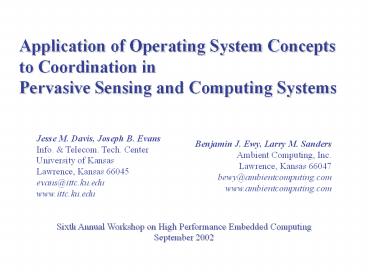HPEC 2002 Briefing - PowerPoint PPT Presentation
1 / 4
Title:
HPEC 2002 Briefing
Description:
Application of Operating System Concepts to ... rapid development and deployment of defense and homeland security applications ... Security and Homeland Defense ... – PowerPoint PPT presentation
Number of Views:14
Avg rating:3.0/5.0
Title: HPEC 2002 Briefing
1
Application of Operating System Concepts to
Coordination inPervasive Sensing and Computing
Systems
Benjamin J. Ewy, Larry M. Sanders Ambient
Computing, Inc. Lawrence, Kansas
66047 bewy_at_ambientcomputing.com www.ambientcomputi
ng.com
Jesse M. Davis, Joseph B. Evans Info. Telecom.
Tech. Center University of Kansas Lawrence,
Kansas 66045 evans_at_ittc.ku.edu www.ittc.ku.edu
Sixth Annual Workshop on High Performance
Embedded Computing September 2002
2
MetaOS Concept
- MetaOS developed by Ambient Computing to
coordinate the function of smart, networked
devices - Smart networked devices include processing
capabilities and sensors - MetaOS provides support for preferences, location
awareness, security - Objective is to ease deployment and use of
systems in the many application areas that have
heterogeneous devices, contain a non-trivial
number of devices, and span multiple locations - Architecture can facilitate rapid development and
deployment of defense and homeland security
applications - Applies operating system approach to groups of
distributed, network-embedded devices - Smart devices and standalone software is
abstracted as resources and peripherals are in
traditional operating systems - Supports easy deployment of new services by
providing common way to integrate and coordinate
devices as well as write applications - Permissions and user profiles handled as in
traditional operating systems
3
Security and Homeland Defense
- MetaOS provides capability for sophisticated
sensor network management - Permissions, preferences, and location awareness
support different processing and views - Multiple levels of access to managed resources
and intelligence information - Operators in different locations can customize
interface to be most effective - Operators with different responsibilities can
customize views for monitoring, investigation,
management - Allows rapid deployment of new sensor processing
applications
4
Architecture Infrastructure
- MetaOS architecture
- Hub (kernel) manages domain, communicates with
devices or programs via edge software (device
drivers) using publish-subscribe approach - Hub, edge, and device are typically on different
network-connected processors - XML messages used for various registration,
notification, operation, and information tasks - Applications interact with system devices through
hub through a standard interface - Infrastructure
- Smart wireless devices
- Tightly integrates embedded wireless, which
qualitatively changes the ability to use
networked intelligence by pushing down cost of
deployment and use - Smart wireless devices allow for deployment of
ubiquitous and low-cost sensing capabilities by
using standard protocols and embedded chipsets to
implement MetaOS-capable devices - Sensors and Processing
- Sensors allow new inputs, processing gives
intelligence
MetaOS Architecture
Smart Wireless Device































